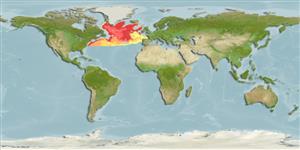>
Lophiiformes (Anglerfishes) >
Linophrynidae (Leftvents)
Etymology: Linophryne: Greek, 'linon' = flax or anything made of flax such as "cord," "rope," or a "net" + Greek, 'phryne' = "toad" (refers to a toadlike fish that fishes with a net) (Ref. 86949).
Environment: milieu / climate zone / depth range / distribution range
Ecología
marino batipelágico; rango de profundidad 400 - 2200 m (Ref. 86949). Deep-water
Northeast Atlantic: Iceland. Northwest Atlantic (Ref. 12965).
Tamaño / Peso / Age
Maturity: Lm ? range ? - ? cm
Max length : 4.1 cm TL macho / no sexado; (Ref. 5951); 23.1 cm TL (female)
Radios blandos dorsales (total): 3; Radios blandos anales: 2 - 3. Metamorphosed females distinguished by the following characteristics: globular escal bulb, surrounded distally and laterally by a blunt ridge in small specimens; absence of escal filaments or other appendages; barbel divided at base into 4 primary branches of nearly equal length, 40-86% SL, each with varying number of secondary and tertiary branches, more or less prolonged into filaments, each with distal photophore; concentration of subdermal melanophores on caudal peduncle; males with pointed sphenotic spines (Ref. 86949).
Life cycle and mating behavior
Madurez | Reproducción | Puesta | Huevos | Fecundidad | Larva
Jonsson, G., 1992. Islenskir fiskar. Fiolvi, Reykjavik, 568 pp. (Ref. 12462)
IUCN Red List Status (Ref. 130435)
Threat to humans
Harmless
Human uses
Más información
Nombres comunesSinónimosMetabolismoDespredadoresEcotoxicologíaReproducciónMadurezPuestaAgregación para la puestaFecundidadHuevosEgg development
ReferenciasAcuiculturaPerfil de acuiculturaRazasGenéticaElectrophoresesheritabilidadEnfermedadesProcesamientoNutrientsMass conversion
ColaboradoresImágenesStamps, Coins Misc.SonidosCiguateraVelocidadTipo de nataciónSuperficie branquialOtolitosCerebrosVisión
Herramientas
Special reports
Download XML
Fuentes de Internet
Estimates based on models
Preferred temperature (Ref.
123201): 2.6 - 3.2, mean 3 °C (based on 70 cells).
Phylogenetic diversity index (Ref.
82804): PD
50 = 0.5000 [Uniqueness, from 0.5 = low to 2.0 = high].
Bayesian length-weight: a=0.01995 (0.00906 - 0.04395), b=3.01 (2.83 - 3.19), in cm total length, based on all LWR estimates for this body shape (Ref.
93245).
Nivel trófico (Ref.
69278): 4.0 ±0.7 se; based on size and trophs of closest relatives
Fishing Vulnerability (Ref.
59153): Low vulnerability (13 of 100).
